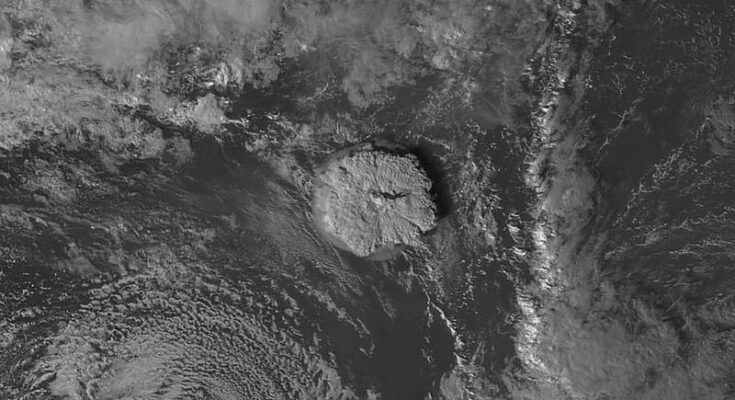With the full picture of damage and needs after the massive Tonga volcanic eruption and tsunami only gradually emerging, what is already clear is that the stakes could not be higher for the farmers and fishers of the South Pacific island nation, living in one of the world’s most disaster-prone regions.
With roughly 86 percent of Tongans engaged in agriculture, FAO is concerned about the potential impacts across all agriculture sectors, including fisheries, crops and livestock. That is despite communications and access remaining severely affected. Initial estimates are that roughly 12,000 agricultural households or 85 percent of the total number, will have been affected by this disaster, according to Xiangjun Yao, FAO Subregional Coordinator for the Pacific Islands, based in Samoa.
“We’re working to assess how bad the impact of this disaster will be on Tonga’s farmers and fishers and all those who depend on forms of agriculture for their livelihoods and food security,” Yao said. “We have been providing support in Tonga after a series of shocks in recent years, of which this is by far the most serious and we are ready to ramp up our work to help these vulnerable communities get back on their feet.
One of the first challenges is assessing the possible impact that the layer of ashfall covering parts of the island, as well as the tsunami damage could have on agriculture and fisheries.
Serious potential effects from ashfall and tsunami
Ashfall can have serious detrimental effects on crops and livestock depending mainly on ash thickness, the type and growing conditions of the crop, the timing and intensity of subsequent rainfall, condition of pasture and animals prior to ashfall, and availability of uncontaminated feed and water.
Root crops, such as sweet potato and yams, could be affected, while fruit and vegetable crops across the archipelago are certainly also at risk. Saltwater inundation will also have likely affected farmland, and the possibility of acid rain is a concern.
FAO preliminary estimates indicate that 60-70 percent of livestock-raising households – mostly pigs and poultry – have had their livestock affected in some way. The expected impact on fisheries is also a cause for concern. While consumption of fish per capita is somewhat low for the Pacific (25-35 kg/year), fisheries could become a more important food source following this disaster, given the potential effects of volcanic ash cover on land which produces local food supplies.
You may also like to read: Food security is increasingly vulnerable to climate-change-induced weather events, says GFSI
Damage to boat ramps and boats is already evident and many of the coastal reefs and lagoons on which healthy fisheries rely are likely to have been damaged or polluted with ash and debris as well as waste from the tsunami.
“With a comprehensive picture yet to emerge, it’s already clear that Tonga will likely require both short- and long-term assistance. FAO is already moving to allocate funds for damage assessments and some initial response measures,” said Yao.
Even before this latest eruption of the Hunga Tonga Hunga Ha’apai volcano, some 23 percent of Tonga’s population was affected by moderate to severe food insecurity.
The agricultural sector contributed nearly 14 percent of Tonga’s GDP in 2015-16 and represented over 65 percent of exports. The main products exported are kava, squash, pumpkins, root crops, coconuts and fish. Fisheries or fishery-related activities are also an important source of food, particularly for communities in the more isolated of Tonga’s 36 inhabited islands.
Experience helping Tonga, dealing with disasters, and volcanic eruptions elsewhere
FAO has been working in Tonga for many years to help strengthen resilience and food security, train young farmers, support women to establish ornamental plant nurseries and make the country’s fisheries more sustainable.
The country – which consists of 169 islands altogether – is one of the 14 Small Island Developing States (SIDS) in the Pacific. The region is among the most disaster-prone in the world, facing a number of natural hazards including cyclones, droughts (including El Niño) and volcanic eruptions. Tonga, Vanuatu, Solomon Islands and Fiji are among the world’s top 15 most at-risk countries from extreme natural disasters, including vulnerability to the climate crisis.
Over the last few years, FAO has been supporting Tonga in its response to a range of shocks and disasters, including Tropical Cyclone Winston in 2016; drought following El Niño in 2016-2017, Tropical Cyclone Gita in 2018 and the continuing impact on fishing communities of the 2014 Tropical Cyclone Ian.
FAO has also provided support in a number of countries hit by recent volcanic eruptions. These include providing critical support both before and after the eruption of the La Soufrière volcano in Saint Vincent and the Grenadines in 2021. FAO focused on protecting livelihoods and averting a deterioration in food security. It helped to evacuate animals, restock lost livestock and provide seeds and tools to enable affected families to get back on their feet as quickly as possible.
Tonga volcanic eruption, Photo credit: Wikimedia Commons





